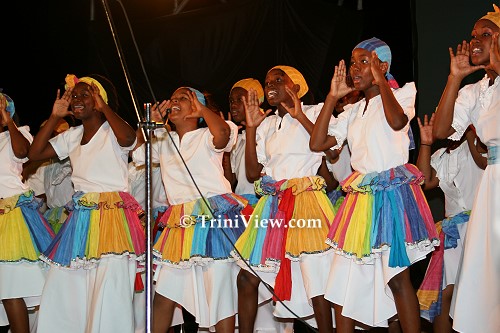 Choir in the play "Sesa Woruban - I Transform Myself"
Choir in the play "Sesa Woruban - I Transform Myself"
TriniView.com Reporters
Event Date: July 27, 2007
The Emancipation Support Committee (E.S.C.) launched the 2007 Emancipation celebrations on Friday night, 27th July, at the Lidj Yasu Omawale Emancipation Village located at Jean Pierre Complex. The theme of this year's celebration is "Remember the Middle Passage; Act to Repair the Damage". According to a release from the E.S.C., "We remember and honour the ancestors for their heroic acts of rebellion and resistance against this inhumane and uncivilized practice of trafficking in human beings, while raising awareness about the enduring impact of slavery and the slave trade on Africa and Africans across the Diaspora."
Chairman of the E.S.C., Khafra Kambon, welcomed the audience and explained that this year's celebration was very special because the year coincides with the 200th year of the abolition of the British slave trade, the 50th year of Ghanaian Independence, the 120th birthday of Marcus Garvey and the 15th anniversary of the Emancipation Support Committee. He proceeded to give an overview of this year's celebrations which includes a tribute concert to the Calypsonian 'Duke', a Pan and Jazz night, a youth day, an international concert as well as a visit by the Ugandan President, Yoweri Museveni.
Minister of Community Development, Culture and Gender Affairs, Joan Yuille-Williams, addressed the audience and acknowledged that African people have been through many battles and carry many scars. She reminded the audience that the past cannot be buried dead, but that it remains alive, resurfacing time and time again. She declared that we liberate ourselves not by avoiding the past but by embracing it and the lessons it teaches. To an audience that one person noted was considerably smaller than last year, Minister Yuille- Williams said, "The triumph of Emancipation is that we seek to emancipate ourselves."
The main feature of the opening was a dramatic theatrical presentation of the African story, titled "Sesa Woruban - I Transform Myself" produced and directed by Pearl Eintou Springer, Noel Blandin, Pat Cambridge and Louis McWilliams. In song, dance, poetry, music and multimedia images, and drawing from the work of Brother Resistance, Eintou Springer, Earl Lovelace, Marcus Garvey, and Calypsonians 'Duke' and 'Chalkdust', the story of Africans were presented in an elaborate fashion. Apart from dramatizing the enslavement process, the directors made it a point to emphasize that enslavement was only a short chapter in the long and glorious history of Africans. The African story was presented in eight movements, each with its own theme.
Sesa Woruban started off with an off-stage voice expressing that Africa has contributed to man's mastery of the world, having created cultures and civilizations, systems of government and the finest art.
From this, dancers acted out in dance the elements of the enslavement process, including the brutality of the Middle Passage experience which the voice of Brother Resistance reminded the audience is the most inhuman voyage ever made by mankind:
You cyar move
ah captive muscle,
in dis stinking slave trader
hustling to de slave market.
Oh Africa...Mudda Africa
Yuh sons an daughters
Shipping slowly
Across the middle passage.
The audience was taken back to the days of slavery, where apart from the physical brutality, African culture and language was forbidden; where enslaved Africans were bombarded with Christianity: a means of indoctrination in an attempt to render the enslaved people docile. In one scene a preacher lectured to a group of slaves telling them that their sufferings and poverty is justified, and that they would be rewarded in heaven. However, the off-stage voice reminded the audience that even though the music, language, and religion of enslaved Africans were banned, there was constant resistance. The Camboulay Riots, the Water Riots, the Butler Riots, the 1970 Black Power Revolt and the Pan African movement were also mentioned as examples of post-Emancipation resistance.
The sixth movement was based on the Calypso by 'Chalkdust' "I Want My Grandfather Backpay" and dealt with the issue of reparations for the atrocities of the enslavement period.
The final movement, titled "I Transform Myself," featured Pearl Eintou Spinger declaring the strength of African culture that manifests in the skin of the drum and in the steel of the pan.
The movement climaxed with the Malick Folk Performing Company demonstrating their talent, combining their energetic dancing with a well-executed dance routine, to the scintillating rhythms of the African drums.
Emancipation Village Opening 2007 in pictures:
www.triniview.com/gallery/main.php?g2_itemId=190553
Back to: Emancipation Celebrations 2007
Homepage | Emancipation Celebrations | Special Events | Photo Gallery
|
